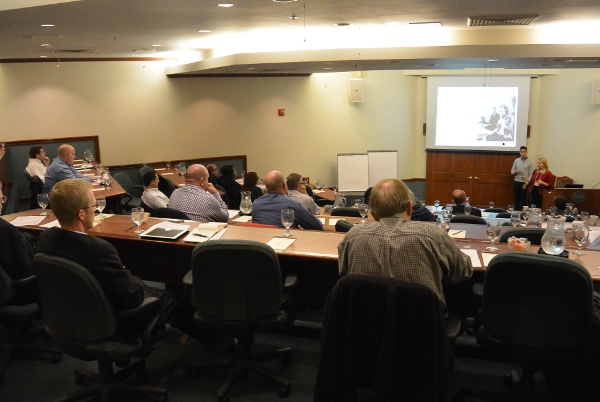5 Big Trends Affecting Polymer Material And Process Selection For Medical Devices
By Jim Pomager, Executive Editor

To say that plastic materials play a central role in the development and manufacture of medical devices would be a gross understatement. Owing to their comparatively light weight, low cost, ease of processing, flexibility, non-ferrous properties (e.g. MRI safe), and superior biocompatibility, medical polymers have become an integral component in a wide range of medical designs — enabling the next generation of implants, single-use devices, and packaging technology, among many others. In fact, global demand for medical polymers reached nearly 5 million tons in 2013, and that amount is expected to exceed 7 million tons by 2020.1, 2
I recently joined a group of medical device makers, material suppliers, contract manufacturers, and other members of the medical plastics community at a one-day event dedicated to medical plastics. Put on by the Medical Plastics Division (and the Philadelphia Section) of the Society of Plastics Engineers (SPE), Technology Advances in Plastic Materials and Processing for Medical Devices crammed a whopping 14 technical presentations into eight hours, covering everything from emerging polymer formulations and injection molding (IM) challenges to new surface finishing technologies (and everything in between).

Attendees take in a presentation during the Society of Plastics Engineers' Technology Advances in Plastic Materials and Processing for Medical Devices conference. Photo Credit: Len Czuba
Throughout the course of the event, several recurring themes emerged during presentations and conversations with attendees. What follows are five major trends medical device OEMs should take into consideration when selecting plastic materials and manufacturing processes for their designs.
1. High Incidence Of Hospital Acquired Infections (HAIs)
Although progress has been made in reducing the risk of acquiring healthcare-associated infections (HAI) in the United States, HAIs remain an enormous problem. According to research in the New England Journal of Medicine (JAMA), approximately 648,000 people contracted HAIs in the U.S. in 2011, or about one out of every 25 patients. A separate investigation published in JAMA Internal Medicine found that the annual cost attributable to five major HAIs was nearly $10 billion per year between 1986 and 2013. Clearly, there is still much work to be done.
One of the primary ways healthcare facilities are combating HAIs is increasing the use of disinfectants to clean surfaces and equipment. Steven Givens, Ph.D., senior polymer application scientist at Eastman Chemical, said that in some hospital systems, rooms are being sanitized every time a nurse enters a room. While popular disinfectant wipes like Wonder Woman and Sani-Cloth certainly help control the spread of HAIs, they can also wreak havoc when they repeatedly come into contact with the polymer materials in medical devices (e.g. equipment housing) — causing pitting, cracking, color changes, and other unintended consequences.
To counteract these negative effects, material suppliers are developing new polymers with higher levels of chemical resistance specifically for medical device applications. Examples discussed during the SPE conference included Bayer’s Makroblend EL4000 polycarbonate (PC) and polybutylene terephthalate (PET) blend, Eastman’s Tritan MX811 copolyester, SABIC’s VALOX polybutylene terephthalate (PBT) and NORYL polyphenylene ether (PPE) resins, and Daikin’s Neoflon perfluoro alkoxy (PFA) copolymer.
2. Replacement Of Traditional Materials
Thanks to ongoing improvements in the physical and mechanical properties of medical polymers (many of which were outlined in the first paragraph of this article), new plastic formulations are regularly substituted for long-established materials in medical device designs. Nowhere is this trend more prevalent than in the area of metal-to-plastic conversion. Many of today’s engineering plastics can rival metals when it comes to tensile strength, and they are obviously lighter, cheaper, more flexible, and easier to process.
Trevor Spence, healthcare sales development manager at Solvay Specialty Polymers, encouraged medical device OEMs to move past the “it’s always been metal” perspective and consider how switching from metal to plastic could actually improve your product and reduce production costs. In his presentation, he shared a case study describing the design and development of a plastic hip retractor that is comparable — and in many ways superior to — its steel counterpart.

Trevor Spence of Solvay Specialty Polymers presents a metal-to-plastic case study. Photo Credit: Len Czuba
The retractor, which was created as a proof-of-concept and is not FDA approved, was injection molded using Solvay’s Ixef polyarylamide (PARA) resin for a single-use version and AvaSpire polyaryletherketone (PAEK) for a reusable version. By adding ribs and reinforcing the polymer with glass fiber, the design demonstrated sufficient rigidity and load bearing capabilities for the application (and in the case of the PAEK version, stronger than a steel retractor). The designers were also able to integrate an ergonomic grip into the design, which, combined with the tool’s light weight, make for a more functional design (potentially combating surgeon fatigue during long procedures). Plus, the cost of manufacturing the injection-molded plastic retractors would be a fraction of what’s required to build the metal version.
3. Cost Containment
Cost-cutting is not a new trend in the medical device industry, but with forces like the medical device tax, payment reforms, globalization, and others bearing down upon them, manufacturers are desperate to find new ways to reduce expenses. And they’re turning to their suppliers — including polymer providers and contract manufacturers — for solutions to the problem.
One way suppliers are helping device makers reduce expenses is by providing novel materials and processing techniques to replace current approaches, as the Solvay retractor case study above demonstrated. Another example was presented by David Shea, healthcare business development manager at PolyOne.
Stoppers/septums for infusion therapy bags and bottles have long been fabricated out of vulcanized rubber. And while rubber still performs reasonably well in the application, the multiple-step process for manufacturing the material is complex and time-consuming.
PolyOne developed its Versaflex HC 2110-35N thermoplastic (TPE) elastomer as an alternative to vulcanized rubber for infusion therapy applications. The material processes in a one-step injection molding operation that takes about 1 minute as a single component or 1 to 2 minutes when co-injected with a rigid material. Unlike rubber parts, TPE parts do not need to be washed, since the process does not involve any crosslinking or processing agents. It also delivers higher levels of quality and consistency.
When viewed in aggregate, these benefits add up to increased production rates and lower manufacturing costs. “Most people still focus on the cost per pound when selecting a material,” Shea said, “but you also need to take the effects of pre- and post-processing steps into consideration.”
4. Environmental Concerns
Medical device companies (and their brethren in other industries) are beginning to respond to the public’s growing awareness of, and interest in, environmental concerns, which is not necessarily a bad thing. However, public pressure to be sustainable and environmentally conscious can sometimes compel manufacturers to make choices they wouldn’t otherwise make — decisions that aren’t always consistent with the latest scientific consensus.
The quintessential example of this trend is the current “BPA-free” movement. BPA (bisphenol A) is one of the primary ingredients in polycarbonates (PCs), one of the most commonly used and versatile groups of medical-grade thermoplastic polymers. In response to thermal oxidation or hydrolysis, PCs can degrade, generating trace levels of BPA. These trace levels of BPA have become the object of great public safety debate. Concerns have arisen that typical BPA exposure — e.g. by drinking liquid from a PC container, eating food from a polymer-lined can, or receiving intravenous fluids via PC-based fluid-handling components — can cause endocrine disruption, hormone mimicry, carcinogenicity, and other human developmental and behavioral issues. As a result of these fears, many medical device makers have decided to go BPA-free with their products.
However, recent university research lab testing, corporate safety evaluations, and government-sponsored investigations have shown BPA to be safe in typical product use conditions at or below established levels (which includes a margin of safety for even worst-case exposure). “FDA and Health Canada safety reviews concluded that there is no basis for the BPA low-dose hypothesis,” Bayer Material Science scientist Pierre Moulinie said during his presentation. “Bayer also runs a healthcare company, so we take this matter very seriously.”

Pierre Moulinie of Bayer Material Science discusses the merits of polycarbonates. Photo Credit: Len Czuba
Research into BPA is ongoing. Medical device makers should stay abreast of the latest findings — and base their decisions about PC use on the current body of scientific evidence and FDA recommendations, rather than simply bowing to public pressure.
5. Emergence Of Bioresorbables
Bioresorbable polymers have been around for over two decades, but their use in medical devices has exploded over the past several years. These materials, which degrade over time and are safely absorbed and excreted by the body, constantly find new applications in medicine, particularly in the areas of drug delivery (e.g. drug-eluting stents), bone augmentation and fixation (screws), and tissue regeneration and replacement (scaffolds).
Bioresorbables have a wide range of benefits. Take, for example, orthopedic plates and pins. When made out of a bioplastic, instead of the traditional titanium, these devices slowly dissolve as they transfer load back to the healing bone. By eliminating follow-up surgery to remove the implant, these devices reduce both healthcare costs and infection risk for patients.
Historically, most bioresorbable polymers have been polyester-based, with two of the most common being polylactic acid (PLA) and polyglycolic acid (PGA). However, new materials are beginning to emerge. During the SPE conference, Peter Gabriele, Ph.D., VP of R&D at Secant Medical, introduced us to Regenerez, a new bioresorbable elastomer developed by Dr. Robert Langer at the Massachusetts Institute of Technology (MIT) and licensed by Secant. Made from poly(glycerol sebacate), or PGS, this “biorubber” (as Gabriele called it) can be customized for various applications — as scaffolding for bone repair, fibers for biotextiles, or coatings for grafts.
One of the major benefits of PGS, Gabriele explained, is that it’s nonimunnogenic, meaning that it doesn’t trigger an immune or inflammatory response by the host, unlike the current generation of biomaterials. “We’re sticking stuff in bodies that has no business being there,” Gabriele said. “The human immune system is telling us we have to do a better job.”
Obviously, this is not a comprehensive list, but rather a sampling of the major trends in medical polymers. However, device makers would be wise to consider how these issues might impact the design and manufacture of next-generation technologies.
"I am surprised how much I learn every time I attend one of these conferences," said Len Czuba, president of design and development firm Czuba Enterprises and organizer/moderator of the event. "The speakers share the latest new polymer technology and developments that device folks would otherwise not hear. The material can be directly put to use when we get back to our companies the next day; it is not abstract information that will take years to bring to market."
SPE’s Medical Plastics Division has now hosted four of these so-called "MiniTec" sessions and plans to bring them to other parts of the country in the coming months. Consider attending one in your area for a more detailed discussion of these and other big trends in medical polymers.
What trends have you encountered related to medical polymers in your work? What challenges have you faced in selecting and using plastics, and how did you overcome them? Please share your thoughts in the Comments section below.
References
